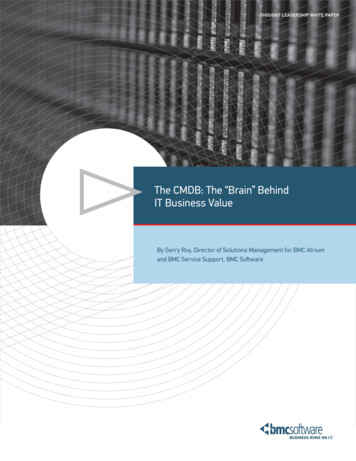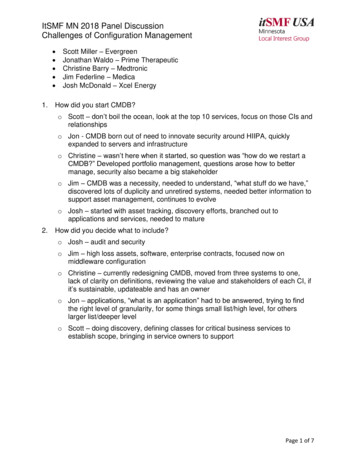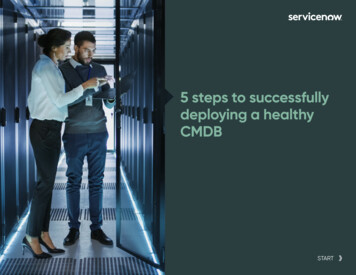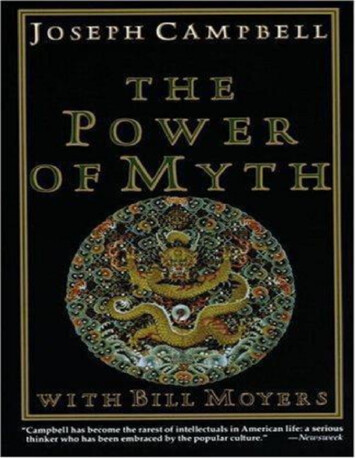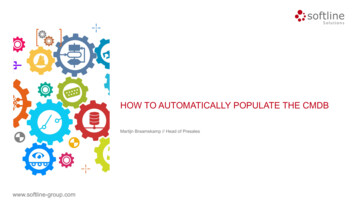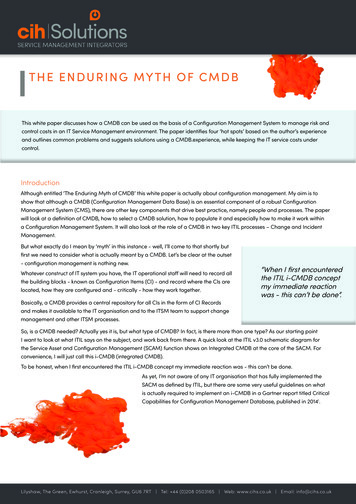
Transcription
T H E E N D U R I N G MY T H O F C M D BThis white paper discusses how a CMDB can be used as the basis of a Configuration Management System to manage risk andcontrol costs in an IT Service Management environment. The paper identifies four ‘hot spots’ based on the author’s experienceand outlines common problems and suggests solutions using a CMDB.experience, while keeping the IT service costs undercontrol.IntroductionAlthough entitled ‘The Enduring Myth of CMDB’ this white paper is actually about configuration management. My aim is toshow that although a CMDB (Configuration Management Data Base) is an essential component of a robust ConfigurationManagement System (CMS), there are other key components that drive best practice, namely people and processes. The paperwill look at a definition of CMDB, how to select a CMDB solution, how to populate it and especially how to make it work withina Configuration Management System. It will also look at the role of a CMDB in two key ITIL processes – Change and IncidentManagement.But what exactly do I mean by ‘myth’ in this instance - well, I’ll come to that shortly butfirst we need to consider what is actually meant by a CMDB. Let’s be clear at the outset- configuration management is nothing new.Whatever construct of IT system you have, the IT operational staff will need to record allthe building blocks - known as Configuration Items (CI) - and record where the CIs arelocated, how they are configured and - critically - how they work together.Basically, a CMDB provides a central repository for all CIs in the form of CI Records“When I first encounteredthe ITIL i-CMDB conceptmy immediate reactionwas - this can’t be done”.and makes it available to the IT organisation and to the ITSM team to support changemanagement and other ITSM processes.So, is a CMDB needed? Actually yes it is, but what type of CMDB? In fact, is there more than one type? As our starting pointI want to look at what ITIL says on the subject, and work back from there. A quick look at the ITIL v3.0 schematic diagram forthe Service Asset and Configuration Management (SCAM) function shows an Integrated CMDB at the core of the SACM. Forconvenience, I will just call this i-CMDB (integrated CMDB).To be honest, when I first encountered the ITIL i-CMDB concept my immediate reaction was - this can’t be done.As yet, I’m not aware of any IT organisation that has fully implemented theSACM as defined by ITIL, but there are some very useful guidelines on whatis actually required to implement an i-CMDB in a Gartner report titled CriticalCapabilities for Configuration Management Database, published in 20141.Lilyshaw, The Green, Ewhurst, Cranleigh, Surrey, GU6 7RT Tel: 44 (0)208 0503165 Web: www.cihs.co.uk Email: info@cihs.co.uk
ITIL and the i-CMDBBasically, the design of an i-CMDB is more than just a repository for configuration data. It is in fact a metadatabase that doesnot store the CI data but connects to several different data sources associated with the CIs. This is known as federation. Thei-CMDB also manages issues around CI reconciliation and synchronisation; and also models and maps logical CI configurationsas a visible graphic for the end users.It’s worth taking a closer look at four of the critical capabilities to see what is involved. The graphic shown below in Figure 1 is asimple representation of how the i-CMDB is at the core of the ITIL SACM and ‘integrates’ all the IT Asset Management (ITAM) CIlandscape with the ITSM processes to create an end-to-end Configuration Management System.Figure 1 - An Integrated CMDB based on ITIL v3.0The four capabilities shown in Figure 1 are:Federation - this is the capability to pull configuration data from several different CI database sources. This is not as easy as itmight appear. The big issue here is that a mechanism is needed to ensure that two CI configuration data sources reference thesame data. Which of the data sources is the one to use? Which one is the authoritative source? This is why reconciliation isneeded.Reconciliation - this is the capability that ensures there is no duplicate CI data. This is achieved by reconciling the location andattributes of the CIs. Reconciliation must also adjust data extracted from more than one CI data source to eliminate duplicationand maintain consistency of CI data.However, this presents something of a conflict. If the reconciliation engine creates a change in one of the CI data sources thenthis change needs to be identified as an approved or a non-approved change. This is done by synchronisation between thefederated CI databases.Lilyshaw, The Green, Ewhurst, Cranleigh, Surrey, GU6 7RT Tel: 44 (0)208 0503165 Web: www.cihs.co.uk Email: info@cihs.co.uk
Synchronisation - this is the capability to maintain synchronisation with all the CI databases. The i--CMDB will need to identifychanges made to the infrastructure and then distinguish between approved changes and non-approved changes. Approvedchanges will be made via the Change Management process for which a Request for Change (RFC) has already been raised.The synchronisation engine will compare the detected change against an approved list of changes and then raise an alert if anunauthorised change is detected.Visualisation - this is the capability to model and map all the CI configurations that form the IT infrastructure landscape andpresent these as a set of logical diagrams that show CI relationships and interconnections in a graphical form that aids ITSMchange management personnel with assessing the impact of a proposed change.So, why do I think the ITIL approach to a CMDB won’t work? There are a number of reasons that come to mind. Is it reallypossible to automate Reconciliation and Synchronisation and be certain that what you finally see is in fact an accurate snapshot of the current system configuration? One example is the recommended use of auto-discovery tools for regular dailyupdates to configuration. Whilst these tools have some useful features what happens when an unauthorised change is made?The discovery tool will certainly pick this change up and suddenly you have a corruption to the configuration. This is where myterm ‘enduring myth’ comes in.The ‘myth’ in this case relates to the widely held belief that once an i-CMDB is designed, populated, deployed and thenautomatically updated, this becomes the single authority at the core of a Configuration Management Sysstem. Also, this beliefhas been around for some years now – hence the term ‘enduring’. I believe this approach introduces a major problem - oneof over dependence on a technical solution. In viewing a federated CMDB as basically an automated solution at the core of aConfiguration Management System there is a risk of supplanting the local knowledge and investigative experience of staff. Thishas obvious risks to service delivery.Imagine, for a minute, that you are chairing a Change Approval Board (CAB) meeting where the i-CMDB impact report statesthat the proposed change has no impact on a business critical system and hence no further impact analysis is needed as thei-CMDB report is definitive and authoritative. Well, good luck with that and I might suggest you keep your CV up-to-date.This appears cynical, but in the real world are we really going to hand over the key decisions for releasing a change basedsolely on an i-CMDB auto-generated report? If not, then why invest vast amounts of annual budget on attempting to do so?There is a paradox here and the way to solve it is to step back from attempting to implement an ITIL v3 compliant i-CMDB andlook at the overall Configuration Management process and how we can improve on what we have by implementing a CMDB aspart of a revised end-to-end Configuration Management process, but not necessarily the core.Lilyshaw, The Green, Ewhurst, Cranleigh, Surrey, GU6 7RT Tel: 44 (0)208 0503165 Web: www.cihs.co.uk Email: info@cihs.co.uk
A Question of ScaleOf course, in IT you can achieve almost any solution as long as you have deep pockets. In the real world most IT organisationsare under pressure on budgets. The exception here maybe large organisations that have extensive IT dependency; for examplea global investment bank with a complex infrastructure. Indeed, you can find some very good case studies on the IEEE XploreDigital Library2 about large scale CMDB installations that encompass 10,000 to 20,000 servers and a million plus CIs. Clearly,with this degree of scale there must be significant investment in an integrated CMDB along the design of ITIL SACM. However, inmy view, these are exceptions and not the rule.So, what are the options for a small to medium size IT organisation that wants to enhance their Configuration ManagementSystem to drive better service delivery, but have budget restraints? Well, here is my list.Option 1 - live without a CMDBOption 2 - leverage existing service desk CMDB functionalityOption 3 - design and build your own CMDBOption 4 - buy a third party off the shelf product and do the implementation yourselfOption 5 - commission a vendor to design and implement the CMDB as a projectOption 1 - live without a CMDBIt is possible to operate a configuration management process without a CMDB, particularly if you are running a very small IToperation - and many organisations do. However, it really makes sense to capture and maintain all relevant CIs in one location,particularly if you are planning to build a Configuration Management System that is based on industry best practice.Option 2 - leverage existing service desk CMDB functionalityThis is more promising. Until quite recently, stand-alone Service Desk applications rarely included a CMDB as part of thefunctionality. However, most Service Desk software these days come as part of an ITSM tool set, and there is usually a CMDBincluded. This is sometime labeled a Configuration Management module, which may or may not be the same thing. There mayalso be an Asset Register that purports to be a CMDB as well, and so on. As there are dozens of ITSM tool sets available, it isdifficult to be prescriptive here but you might be fortunate to have a Service Desk application that is part of an ITSM tool set thatalso has CMDB built-in. Often as not, this part of the ITSM functionality is left disabled or only part implemented.More on this later.Option 3 - design and build your own CMDBI have already assumed that a multi-dimensional i-CMDB with all the associated interfacing will be difficult to implement so Iwould suggest that this is not even attempted by in-house design personnel. That said, if the CMDB is going to be a relationaldatabase design as previously described, then this is feasible as an in-house project. However, the downside means divertingkey personnel for a design and build project that could take several months to implement. But it is a possible option.Option 4 - buy a third party off the shelf product and do the implementation yourselfThis is a minefield. There are numerous vendors that claim to offer CMDB solutions. Some explicitly state that their CMDB is adimensional database and can be connected to your IT systems to provide all the federation, reconciliation, synchronisation andmodelling needed to reach ITIL compliance. This may be so, but that is not our preferred approach as discussed previously.There are also vendors who offer a CMDB relational database off-the-shelf and ready for inputting your CIs.This could work but a word of caution. Out-of-the-box products often require third party consultancy to get them workingcorrectly and the billable hours can clock up at an alarming rate. However, that said, it is a valid option and worth considering.Lilyshaw, The Green, Ewhurst, Cranleigh, Surrey, GU6 7RT Tel: 44 (0)208 0503165 Web: www.cihs.co.uk Email: info@cihs.co.uk
Option 5 -Commission a vendor to design and implement the CMDB as a projectSome vendors offer a bespoke CMDB but of course these will require a lot of expensive consultancy to implement fully, and few,if any, are that successful. The budget will be blown well before full implementation is achieved. This is my least favourite optionas it has a high risk of failure.So, which option(s) to choose? My first preference would be for Option 2. Look at what you already have included in your ServiceDesk software in the way of a relational database that will hold CIs. If it doesn’t, then check with your Service Desk supplier incase there is a CMDB add-on module that is available.Failing that, then I would look closely at Option 3 - build something yourself, and then Option 4 buy an off the shelf product.Note: Should you be considering an upgrade to your Service Desk then this would present an ideal opportunity to factor in aCMDB as one of the core functions of the new Service Desk.Selecting a CMDBSo, in summary, we are looking at a monolithic, rather than a federated CMDB. It is also likely to be a relational database modelrather than a multi-dimensional CMDB. At this point I don’t want to delve into the merits of relational databases versus multidimensional as this is outside of the scope of this paper. The key point I wish to make is that a relational database with multipledata tables built as sets of CI Records will provide a good working solution that combines semi-automatic and manual methodsof controlling data changes to the CMDB.This approach will depend on the database model of the Service Desk provider in Option 3 and the CMDB vendor in Option 4. Ifyou choose Option 2, then you have the opportunity to research alternatives to the relational model approach. For the purposeof this paper I am assuming a relational database model.Asset RegisterBefore I look at the steps for setting up of a CMDB, I want to touch on Asset Registers. These databases are often bundled withService Desk software and sometimes vendors call them a CMDB. This is not true and an Asset Register is simply an inventory ofhardware and software assets so that the ownership, purchase order history and licence management of assets can be trackedover the asset life-cycle - procurement to disposal. True, there will be some correlation with the CIs held in the CMDB and theywill need to be kept synchronised.Selecting the Configuration Item (CI)So, what CIs do we need to capture to populate the CMDB? There are three main considerations and these are:Consideration 1 -the scope of the CIs under control;Consideration 2 - the attributes that need to be captured to create a CI RecordConsideration 3 - the relationship and dependencies between the various CIsLilyshaw, The Green, Ewhurst, Cranleigh, Surrey, GU6 7RT Tel: 44 (0)208 0503165 Web: www.cihs.co.uk Email: info@cihs.co.uk
Consideration 1 -the scope of the CIs under controlWhat CIs do you actually want to control? If you can’t control a CI then you can’t change it and so it has no place in the CMDB. Ibelieve it is best to start top down and start small.As your Configuration Management System starts to stabilise and mature then add more CIs. Also, you should only be identifyingCIs that are critical to the IT services you are providing. I’d certainly leave out including personnel (ideally located in HR System),documentation (ideally located in a KM System) and peripheral assets (ideally located in the Asset Register).One possible way to restrict the number of CIs in your CMDB is to limit the CIs to those associated with Business Critical systemsand some Non-Critical Systems. I would agree that this is not always possible as a lot of services are shared, but it is worthexploring. A possible sub-division might be made according to Severity:1.All Business Critical and some non-Business Critical systems usually covered bySeverity 1 and Severity 2 – locate in the CMDB;2.All the remainder non Business Critical and also Legacy systems usually coveredby Severity 3 and 4 – locate in a KM Database.Consideration 2 - The attributes that need to be captured to create a CI recordThe second consideration is the number of attributes that you want associated with each CI Record. Some common attributesare in the table below. Clearly, this is not exhaustive and a good source reference for identifying CI Attributes can be found in theITIL Templates3Note that CIs can be linked by relationship to ITIL processes, for example Incident Reports where the CI in question is associatedto a particular service failure. Also, Service Reports where metrics can be collected about CI performance, like reliability. More onthat later under Hot Spot scenarios.No.Description of Atribute1Unique Identifier2Classification3Description4Relationship to Incident Reports5Relationship to other CIs6Location7Dependencies8Manufacturer9Service Report10Modification HistorynRelationships to the IT Servicesn 1Details of the relationshipbetween the CI and IncidentReportts (See Hot Spot 2)History of MTTR and MTBRand other metrics for anindividual CI(See Hot Spot 3)License NumberLilyshaw, The Green, Ewhurst, Cranleigh, Surrey, GU6 7RT Tel: 44 (0)208 0503165 Web: www.cihs.co.uk Email: info@cihs.co.uk
Remember, the fewer attributes you have the easier it is going to be to maintain the CMDB. However, the attributes must berelevant enough to ensure that the CIs are identified correctly during the change management process. This trade off can onlybe resolved by the Configuration Management build team during the CMDB design phase.Consideration 3 - The relationship and dependecies between the various CI RecordThe third consideration is the relationship between the CIs. You need to know how the CIs are related to each other. Some typicalquestions about CIs are: Is it stand-alone? Is it an over-arching CI that has sub-ordinate CIs? Is it a component of something else – another CI? Is it a new version of an existing CI? Is it a replacement for an existing CI? Is it now redundant due to a change to the IT environment?tThis is a critical piece of work and identifying the dependencies between the CIs and building up a picture of the network ofrelationships that underpin the IT systems.Populating the CMDBOnce the CIs have been collected as a set of CI Records we need to start to populate the CMDB. This is not a trivial exercise andmust be a managed as a joint project between the Change Management and Configuration Management teams. Basically, thesteps needed for the CI Record population are:1.Freeze all current Change Requests (whilst a difficult task this will ensure that whatyou populate is an actual baseline configuration);2.Create sets of CI Records that are divided into layers that relate to domainresponsibility (this reduces the chance of erroneous updates to non-impacted CIs).3.Perform one time population of some CI attributes using agentless auto-discoverytools (this will help speed the process);4.Perform manual data uploads of the other CI attributes using pre-definedtemplates (these will have been compiled during the CI selection activity);5.Perform a verification and audit on CMDB to ensure that everything has beencaptured.Maintaining the CMDBNow we have the baseline configuration it needs to be maintained and so monitoring and control of the CIs is critical. This mustbe the responsibility of the Configuration Managers, supported by Subject Matter Experts (SME’s) for the IT domains of ServerInfrastructure, Network Infrastructure and Application Management. Each domain is supported by various system monitoringand configuration tools, together with device management tools to extract the changes to the configuration data.The CI change data is compiled as part of the normal Change Management process. The data is collected part manually (bySMEs) and part automatically (by configuration tools) to create a consolidated CI Data Table of changes that can be uploadedto the relevant CI Records within the CMDB, once the changes have been approved. This upload is initiated manually oncethe change is approved by the Configuration Management team. This method might appear a shade cumbersome but it hasthe advantage of ensuring a final ‘human’ decision to change the CMDB, as opposed to a fully automated one. The process isshown in Figure 3 on the next page of this document.Lilyshaw, The Green, Ewhurst, Cranleigh, Surrey, GU6 7RT Tel: 44 (0)208 0503165 Web: www.cihs.co.uk Email: info@cihs.co.uk
Figure 3 - Process for Maintaining the CMDBMaintaining the CMDBNow we have the baseline configuration it needs to be maintained and so monitoring and control of the CIs is critical. This mustbe the responsibility of the Configuration Managers, supported by Subject Matter Experts (SME’s) for the IT domains of ServerInfrastructure, Network Infrastructure and Application Management. Each domain is supported by various system monitoringand configuration tools, together with device management tools to extract the changes to the configuration data.The CI change data is compiled as part of the normal Change Management process. The data is collected part manually (bySMEs) and part automatically (by configuration tools) to create a consolidated CI Data Table of changes that can be uploadedto the relevant CI Records within the CMDB, once the changes have been approved. This upload is initiated manually oncethe change is approved by the Configuration Management team. This method might appear a shade cumbersome but it hasthe advantage of ensuring a final ‘human’ decision to change the CMDB, as opposed to a fully automated one. The process isshown in Figure 3 on the next page of this document.Lilyshaw, The Green, Ewhurst, Cranleigh, Surrey, GU6 7RT Tel: 44 (0)208 0503165 Web: www.cihs.co.uk Email: info@cihs.co.uk
As mentioned, there will be a number of sources used for making a CI Record change:System Management Tools - this is a very broad category and vendor products will vary considerably in functionality. Most,however, will provide data on device location, identification and status. Plus, of course Software Application Management (SAM)tools. These data will be monitored by the change management team.Device Configuration Databases - this is usually a set of predefined databases containing configuration data for allconfigurable devices in the system. A record is kept of each device currently connected to a system and will be updated by aninternal device configuration manager as changes are made.Auto-discovery Tools – as mentioned previously, auto-discovery tools are best used for the initial population of the CI Records.For CMDB maintenance, auto-discovery tools cannot replace the manual and structured monitoring and control activities ofexperience staff. For example, auto-discovery tools are not good at detecting relationship changes between CIs. This must bedone manually.Visualisation - most management tools have some form of feature to visualise the relationship of components anddependencies. Although not a CI data source as such, this ability to map the devices will assist the configuration manager inmaking decisions on impact analysis, particularly when communicating with other configuration managers.Designing the Configuration Management SystemIn the previous sections we looked at the two main types of CMDB - relational and multi-dimensional. I’ve suggested that arelational CMDB will work, but with some constraints. I’ve also looked at the various options for sourcing a CMDB and oncesourced, provide suggestions on populating the CMDB with a selection of critical CIs, together with the appropriate attributes.This will create a baseline configuration against which all future system and service changes can be made and recorded.We now move on to designing our re-engineered Configuration Management System. Our next step is to put in place aConfiguration Management System management team. A suggested list of key positions are: Lead Configuration Manager Server infrastructure Configuration Manager Network Infrastructure Configuration Manager Applications Management Configuration ManagerWe are now ready to construct a Configuration Management System that uses the CMDB as a single source of reference for CIs.I’m only going to touch on the high level process and our starting point must be a Configuration Management Workflow thatconnects all the functions involved with a configuration change.It’s possible that a Configuration Management Workflow feature already exists within your Service Desk functionality. This maycome bundled with the Incident, Problem, Request Fulfilment processes. If not, then it should either be possible to adapt oneof the Service Desk other workflows to do the job, or alternatively there are a number of third party off-the-shelf workflowpackages available.Lilyshaw, The Green, Ewhurst, Cranleigh, Surrey, GU6 7RT Tel: 44 (0)208 0503165 Web: www.cihs.co.uk Email: info@cihs.co.uk
Figure 4 - Configuration Management System using a CMDBHowever, once a change has been authorised then the Configuration Management Workflow will take the required change andtrigger the actual technical build of the change to the CI (or groups of CIs). There then follows an Approval by the owners of theinfrastructure which is impacted. Once this is granted the technical teams will Install and then Validate the change, ready forRelease. A Roll-Back step is included should the change create a problem and the change needs to be reversed.This is a normal Configuration Management System practice. However, as we now have a CMDB in place then once the changehas been released the CMDB will need instant updating. In my view this is a red flag step. As explained under the Maintainingthe CMDB heading, each of the Server, Network and Application teams must have a dedicated Configuration Manager who willbe responsible for collating, reconciling and the uploading the change to the CI Layers in the CMDB. This must be done formallyas part of the change release, not as an administration task to be sorted at a later date.Maintenance of the integrity of the CMDB is the cornerstone of the Configuration Management System. Once the CI databecomes out of sync with the actual systems then the CMDB will become useless and give false impact reports. To drive thisfunction there must also be an overall Configuration Manager (with authority) to oversee the whole end-to-end process andfacilitate communication between the Change Manager and the technical teams. This is probably one of the most importantroles to drive good Configuration Management practice.A regular audit of the CMDB must be conducted by the Configuration Management team to ensure that the integrity of theconfiguration is maintained and reconcile any differences that might have occurred between the CIs as a result of the changesintroduced since the last audit.Lilyshaw, The Green, Ewhurst, Cranleigh, Surrey, GU6 7RT Tel: 44 (0)208 0503165 Web: www.cihs.co.uk Email: info@cihs.co.uk
Example ‘Hot Spots’I’ve identified four typical ‘hot spots’ based on personal observations of real life events involving inadequate or erroneous systemconfiguration data that have been the cause of major service outage.These are shown in Figure 5. Clearly, there will be others depending on the set-up of a particular ITSM organisation and thetypes of client it supports.Figure 5 is based on a simplified ITSM organisation that could be either a MSP dedicated to external clients, or an ITSMorganisation providing IT services to an internal client. The IT Operations can be either internal or external hosting with orwithout applications support. It assumes that all key components are under the control of the IT organisation.For the purpose of this paper it is assumed that the IT Operations is in-house and provides hosting, communications andapplications support - within an overall governance framework.There are four example ‘hot ‘spots’ shown in Figure 5. Hot Spot 1 (Change Management) – Risk to service delivery due to poor change control Hot Spot 2 (Incident Management) – Risk of service failure due to poor incident resolution time Hot Spot 3 (Availability Management) – Risk to service recovery due to extended CI repair times Hot Spot 4 (Service Continuity) – Risk to service continuity due to lack of data on current system configurationAll of the above examples involve insufficient knowledge of current IT system configuration and the following narrative willdescribe how the implementation of a more robust Configuration Management System with a CMDB can help mitigate theserisks.Figure 5 - Example Hot SpotsLilyshaw, The Green, Ewhurst, Cranleigh, Surrey, GU6 7RT Tel: 44 (0)208 0503165 Web: www.cihs.co.uk Email: info@cihs.co.uk
Hot Spot 1 - Risk to Service DeliveryThe ‘Risk’ we are trying to mitigate here is one of a poorly managed change request that leads to an uncontrolled serviceoutage and associated breach in SLAs. Typically, this is due to inadequate Impact Analysis resulting from: an incomplete baseline for the current system configuration; insufficient understanding of dependencies and relationships between the CIs; unclear ownership of CIs; poor communication between technical teams.The implementation of a CMDB as outlined in this paper will eliminate many of the above deficiencies, but of course notechnology solution on its own will compensate for poor teamwork and team communications. In this scenario I’ve created abasic Change Management process to demonstrate how these risks to service delivery can be mitigated by using a CMDB asthe source of the current baseline, plus supporting analysis from technical teams based on ITSM tool sets and local experiencefrom SMEs.Figure 6 shows a simplified Change Management process with a Change Advisory Board as the forum for bringing together thevarious inputs for analysis.Figure 6 - Reducing Risk to Service DeliveryLilyshaw, The Green, Ewhurst, Cranleigh, Surrey, GU6 7RT Tel: 44 (0)208 0503165 Web: www.cihs.co.uk Email: info@cihs.co.uk
For the purpose of this scenari
simple representation of how the i-CMDB is at the core of the ITIL SACM and 'integrates' all the IT Asset Management (ITAM) CI landscape with the ITSM processes to create an end-to-end Configuration Management System. Figure 1 - An Integrated CMDB based on ITIL v3.0 The four capabilities shown in Figure 1 are:



